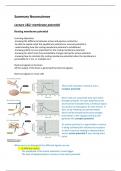Summary
Summary neuroscience, neurophysiology
- Course
- Institution
I passed this course with the help of these summaries with a 9! It contains all lecture material including all slides. NOTE: I used the anatomy slides that were given and the summary Antonio made. These are not included in this summary. This was sufficient!
[Show more]



